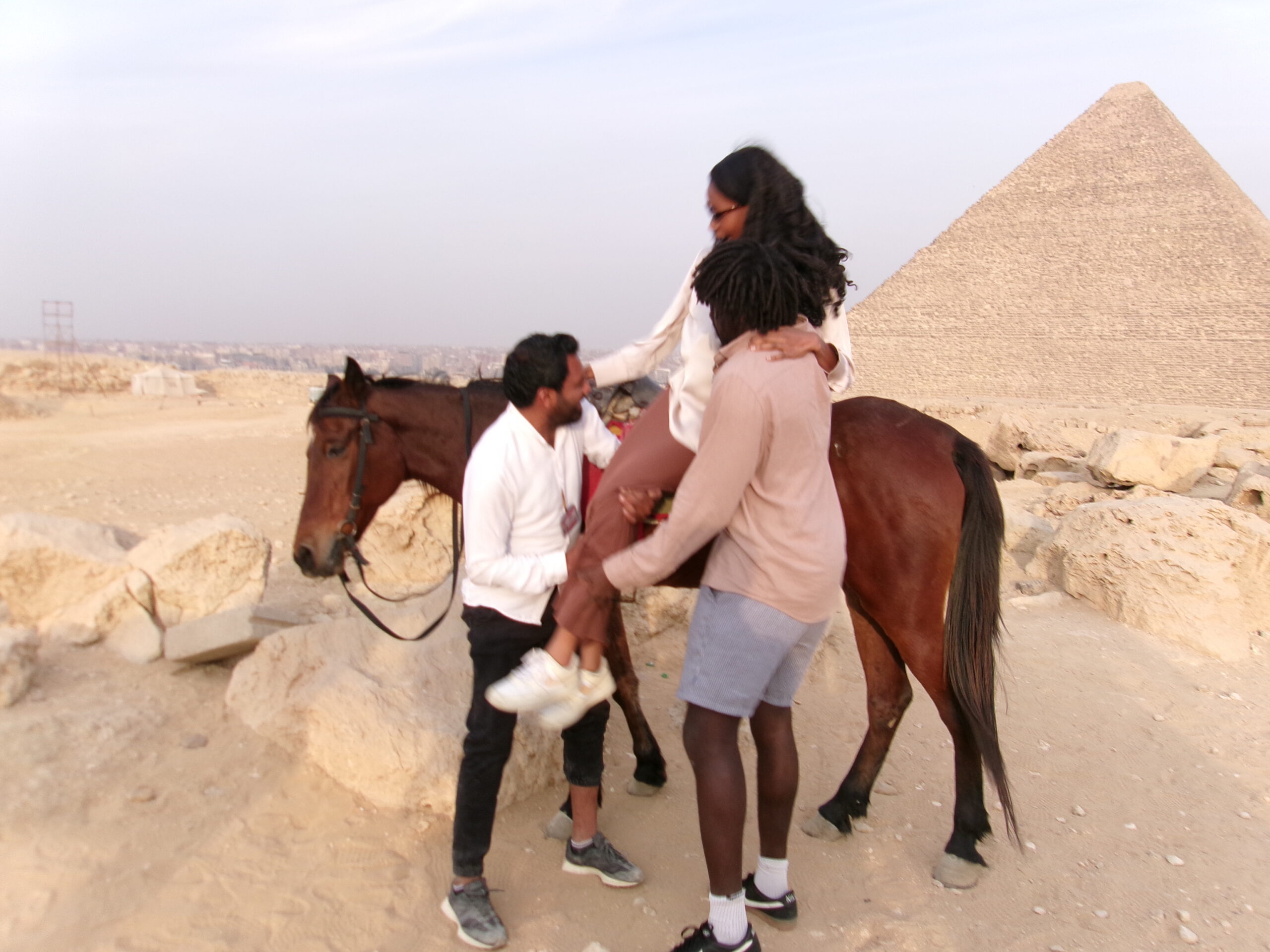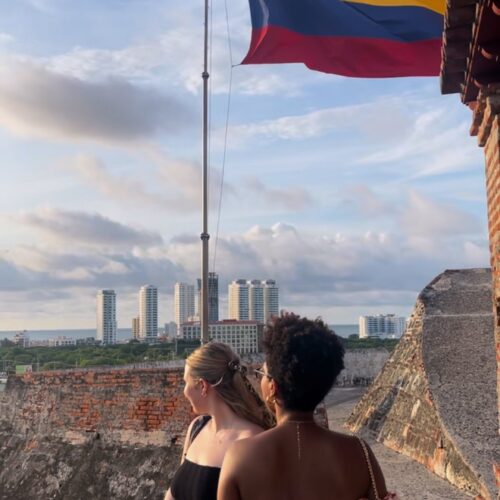As a young traveler on a budget, your trip-planning process probably includes scouring the internet for cheap flights. Many of us are no strangers to budget airlines, third-party booking websites, and– of course— long layovers. However, while most of us don’t hesitate about booking a cheap airline on a discount website, a long layover may inspire us to raise our price point. After all, who wants to spend seemingly endless hours in an uncomfortable airport?
Trust me, I understand the frustrations that come with those excessively long layovers. For many years, I avoided them myself. However, once I learned how to make the most of my layovers, I began purposefully seeking out flights with long layovers, rather than avoiding them.
Just this week, for example, I spent a day in Cairo and just casually stopped by the Pyramids of Giza! I have been to Egypt twice this year simply because I embrace budget flights that come with long layovers. I mean, isn’t it a steal that I got to go to Cairo and Nairobi for $500?! (For context, one way tickets from New York to Nairobi are typically upwards of $1200 in December, but I got mine for more than ½ that price!)
Therefore, rather than seeing long layovers as an inconvenience, think of them as an opportunity. If done right, a layover can give you the chance to explore another destination, essentially turning one trip into two.

- Make sure your layover is long enough
- Research whether your airline has a stopover program
- Ensure your transit city is layover-friendly
- Make a plan for getting into the city
- Decide What Activities Are Time-Appropriate
Make sure your layover is long enough
To make an adventure out of a layover, you need to have at least 6 hours between your flights. This is because, on any given layover, you will lose about three hours going to and from the airport. The average airport is located anywhere from 30 minutes to 1 hour outside of the city center, so you need to budget an hour each way for travel. You also need to get back to the airport at least 1 hour before your flight to navigate security and make it to your gate. Thus, any layover less than 6 hours would only give you 1-2 hours to explore. Ultimately, leaving the airport on such a time crunch may be more stressful than enjoyable.
The sweet spot for a layover is 8+ hours, which gives you about five hours in the city—enough time for a meal and some sight seeing. The best layovers, though, are 12+ hours. With nine hours to explore, you can fit in a full day of activities and really experience the city. On my most recent trip to Egypt, I landed at 10am and flew out at 10pm. In those 12 hours, I had time to grab breakfast, get a tour of old Cairo, spend the day in Giza, and have dinner all before my flight. (You can book the tour I did with GetYourGuide!)
In addition to ensuring that your layover is the right length, you also need to verify that it is at the right time. Daytime layovers are ideal since that is when most attractions and restaurants are open. It is also much safer to arrive in a foreign city during the day, especially during business hours. If your layover is overnight, ensure you’ll have some daylight hours to make the most of it.



Research whether your airline has a stopover program
Because of stop-over programs, I have received free hotel stays in destinations as diverse as Addis Ababa, Ethiopia; Dubai, UAE; and– of course– Cairo, Egypt. Stopover programs are subsidized programs offered by select international airlines, and they provide perks like free hotel stays, airport-hotel transportation, and transit visas for passengers with long layovers (typically 8+ hours).
Most airlines host their stopover programs in the city where they are headquartered— so, Qatar has a stopover program in Doha, Emirates has one in Dubai, Ethiopian has one in Addis, and Egypt Air has one in Cairo. Therefore, if you want a stopover in a specific city, try to book the airline that is headquartered there. For example, if you want to go to Cairo, book with Egypt air.
It’s important to note that these programs often require you to ask for the stopover benefits. When you land, head to the airline’s information counter and inquire about the stopover program. Don’t assume they’ll automatically notify you—I missed out on several free hotels early in my solo travel days because I didn’t know to ask.
If your airline doesn’t offer a stopover program, don’t worry. You can still make the most of your layover. If you have an overnight layover, consider booking a nearby airport hotel at your own cost. Major hotel chains have properties in capital cities throughout the world, and sites like Expedia can help you compare options.
I once had a 16 hour layover in Frankfurt, Germany and Lufthansa did not offer a stop-over so I went online, booked a room in a hotel chain that I recognized, slept until the sun rose and then left the hotel the next day to explore the city. I got to try bratwurst for the first time and I also visited the beautiful Frankfurt Christmas market. I may not have had a subsidized hotel, but I have no regrets because I still got to see a new city!



Ensure your transit city is layover-friendly
Not all destinations are layover-friendly. If your airline does not offer a stopover program, you’ll need to do some research to ensure the city is worth transiting in. Key questions to ask include:
- Can you access the country? Do you need a visa, or is a transit visa available on arrival?
- What is there to do in the city? Are there attractions, restaurants, or unique sights?
Major cities and capitals are the best layover destinations because they offer plenty of restaurants at which you can eat, sights which you can see, and a sense of safety in numbers. Most of the time when you fly internationally, your layover will be in a big city. Nonetheless, double-checking is always a good idea– you do not want to have a day-long layover in some remote place which does not offer much to do.
While you research what to do during your layover, you should also research options for storing your bags (if necessary). Having heavy luggage can definitely detract from the layover experience, and certain establishments (museums, tourist sites etc) may not allow you to enter with large bags, let alone suitcases. Therefore, you will need to determine whether you can easily leave the airport and navigate the city with your luggage.
On occasions when I do not have a transit hotel, I always opt to pack a light carry-on such as a backpack. If you tend to pack a heavy carry-on, look into whether the airport in your transit city has a place where you can store your bags for a day. When I had a layover in São Paulo on my way to Rio, my friends and I paid to put our bags in lockers at the airport. We were then able to go enjoy lunch and a visit to the Afro-Brazil museum without lugging any heavy bags. It is important to recognize, though, that not every airport offers luggage storage. You will thus need to determine what you plan to do with your bags before your flight!

Make a plan for getting into the city
Most airports are located on the outskirts of a city, if not altogether outside them, so planning your transportation into town is essential. Start by checking if public transport is an option. For example, some airports have train stations within the terminal. For example, in Paris you can reliably take the train straight from Charles de Gaulle airport to the center of the city. The same is true for Casablanca. A direct train into the city is often a convenient, cheap, and safe option; so make sure to research that possibility!
If there’s no train, look for a transportation service you recognize, such as Uber or another rideshare app. As a solo traveler, I prefer official public transportation like trains or metros during the day. However, when public transport is not an option or when it is dark outside, I prefer rideshare apps like Uber, because they are rackable, reliable, and less likely to result in overcharging. Keep in mind that Uber isn’t available everywhere, so it is important to research popular rideshare apps in your destination ahead of time. For instance, I’ve had to use InDrive in Morocco, Careem in Dubai, Yango in Yaoundé, and Bolt in Dar es Salaam.
You can also use traditional taxi cabs, although I must admit, they are usually not my first choice. However, I do not mind using them when I can confirm they are from an official company, I can communicate with the driver in a language I know, and I have some sense of where I’m going. For navigation, download apps like Citymapper, which I find much more accurate than Apple Maps on my iPhone. If Citymapper isn’t available in your destination, Google Maps is a reliable alternative.

Decide What Activities Are Time-Appropriate
The length of your layover will determine what you can realistically do. With a short layover, you might only have time for a memorable meal. For instance, I once had a 7-hour layover in Paris (just 4 hours in the city!) and spent it enjoying crêpes with a friend.
If you have 8+ hours, you can fit in a meal and one or two attractions. Most recently, I had a 10 hour layover in Morocco, and I managed to grab a traditional meal with friends, visit a mosque, experience a hammam, and have dinner before taking the train back to the airport.
For layovers of 12+ hours, consider full-day excursions. When I had a 70+ hour layover in Dubai in 2021, I got to visit the World Expo— an international exhibition of art and culture that happens every 5 years. These kinds of experiences are what make long layovers so memorable.
Once you know what you can realistically do with your time, plan your day. Even if you typically prefer a relaxed travel style, having a loose plan is essential for layovers. With such a limited window, a little preparation goes a long way in making your time enjoyable and stress-free.



Making the most of a layover requires planning and a bit of research…
but it’s always worth it to turn downtime into an adventure. By ensuring your layover is long enough, familiarizing yourself with transportation options, and preparing for the unique opportunities each destination offers, you can transform what might have been a tedious wait into a mini trip of its own. Whether you’re exploring a bustling city, savoring a local meal, or ticking off a major attraction, every layover is a chance to add another layer to your journey. So next time you’re booking a flight, don’t overlook the potential of a well-planned layover—it could become one of the most memorable parts of your trip.


[…] tour was done on a time crunch (we only had an afternoon in Cairo since we were just there on a layover), so I appreciated the fact that our hotel was able to make it happen on such short […]